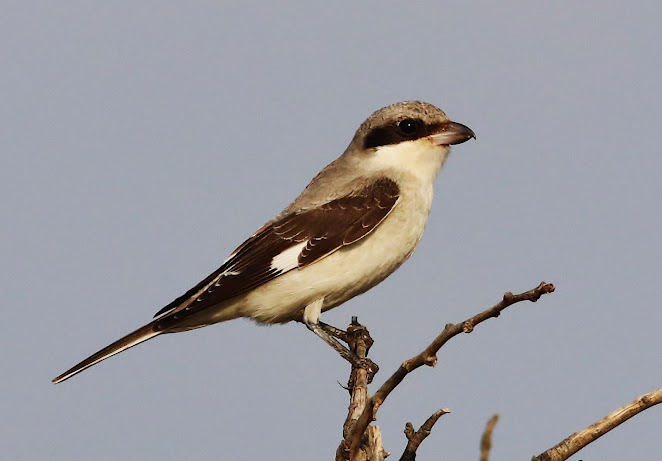
 The lesser grey shrike (Lanius minor) is a member of the shrike family Laniidae. It breeds in South and Central Europe and western Asia in the summer and migrates to winter quarters in southern Africa in the early autumn, returning in spring. It is a scarce vagrant to western Europe, including Great Britain, usually as a spring or autumn erratic.
The lesser grey shrike (Lanius minor) is a member of the shrike family Laniidae. It breeds in South and Central Europe and western Asia in the summer and migrates to winter quarters in southern Africa in the early autumn, returning in spring. It is a scarce vagrant to western Europe, including Great Britain, usually as a spring or autumn erratic.
It is similar in appearance to the great grey shrike Lanius excubitor and the southern grey shrike Lanius meridionalis being predominantly black, white and grey, with the males having pink-flushed underparts. It is slightly smaller than the great grey shrike, and has a black forehead and relatively longer wings. This species prefers dry open lowlands, and is often seen on telephone wires.
 This medium-sized passerine eats large insects, especially beetles, butterflies, moths and grasshoppers. Like other shrikes it hunts from prominent perches and sometimes impales corpses on thorns or barbed wire as a "larder".
This medium-sized passerine eats large insects, especially beetles, butterflies, moths and grasshoppers. Like other shrikes it hunts from prominent perches and sometimes impales corpses on thorns or barbed wire as a "larder". The lesser grey shrike spends the summer in South and Central Europe and western Asia. It breeds in southern France, Switzerland, Austria, Czech Republic, Italy, the former Yugoslavia, Albania, Greece, Romania, Bulgaria and southern Russia. In Asia it breeds in the Middle East, its range extending as far as eastern Turkey and Iran. It is a vagrant to more northerly parts of Europe, usually in spring or autumn. Countries where it has been seen include Sweden, Finland, Denmark, United Kingdom, Netherlands, Belgium and northern France. It is a migratory species and winters in a broad belt across tropical southern Africa.
The lesser grey shrike spends the summer in South and Central Europe and western Asia. It breeds in southern France, Switzerland, Austria, Czech Republic, Italy, the former Yugoslavia, Albania, Greece, Romania, Bulgaria and southern Russia. In Asia it breeds in the Middle East, its range extending as far as eastern Turkey and Iran. It is a vagrant to more northerly parts of Europe, usually in spring or autumn. Countries where it has been seen include Sweden, Finland, Denmark, United Kingdom, Netherlands, Belgium and northern France. It is a migratory species and winters in a broad belt across tropical southern Africa.
During the summer the lesser grey shrike inhabits open countryside, the edges of cultivated areas, heathland with scattered bushes and trees, gardens, coppices, woodland and roadside trees. In its winter quarters it is usually found in scrubland and among thorn trees.
The lesser grey shrike hunts from a strategic post, wire or branch and primarily feeds on insects which it catches in the air or on the ground. The diet includes beetles, moths and butterflies, large flies, grasshoppers, crickets and millipedes. Some fruits such as cherries and figs are eaten to a limited extent. The bird occasionally impales freshly caught prey on thorns for use later, but this is done to a much lesser extent than by some other shrike species. It has been shown experimentally that this species only creates a larder when it is satiated and that prey items are seldom plentiful enough for this to be the case. The male has been observed to feed the female before starting to create a food store. Repeated experimental exposure of birds to a food surplus significantly increases the rate at which they impale freshly caught prey. Other causal factors in the failure of this species to hoard may be a shortage of suitable caching sites and the fact that the bird lacks practice in storing food and this constrains its learning ability.
The flight of the lesser grey shrike is low and somewhat undulating and it occasionally glides with extended wings. At the end of the flight it swoops upward to land on a new hunting perch. It then turns its head from side to side searching for prey. When on the ground it hops, but it normally only stays there for long enough to pick up an item of food. Like other shrikes, when excited it fans its tail and moves it up and down or from sided to side. It is pugnacious and will defend its nest with vigour and drive away larger birds.
The nest is often built in a roadside tree with good all-round visibility some 4 to 10 metres (13 to 33 ft) off the ground. It is built by both birds out of the stems of various flowering plants such as cudweed (Gnaphalium) and (Filago), and thyme (Thymus), and lined with whisps of wool, hairs, roots and feathers. There are five to seven eggs in the clutch, usually bluish green blotched with greenish-brown. Sometimes the background colour is cream or buff with pinkish-brown blotches. Their average size is 26.1 by 18.2 millimetres (1.03 in × 0.72 in). Incubation lasts about fifteen days and is chiefly done by the female though both parents take part. They both feed the young which are ready to leave the nest after about fourteen days. There is usually a single brood. From Wikipedia, the free encyclopedia
Photos Agios Sozomenos by George Konstantinou

%20%20-%20%CE%A3%CF%84%CE%B1%CF%87%CF%84%CE%BF%CE%BA%CE%B5%CF%86%CE%B1%CE%BB%CE%AC%CF%82%20%20(3).JPG)

%20(%20Gmelin,1788)%20%CE%A3%CF%84%CE%B1%CF%87%CF%84%CE%BF%CE%BA%CE%B5%CF%86%CE%B1%CE%BB%CE%AC%CF%82%20(1).JPG)
No comments:
Post a Comment